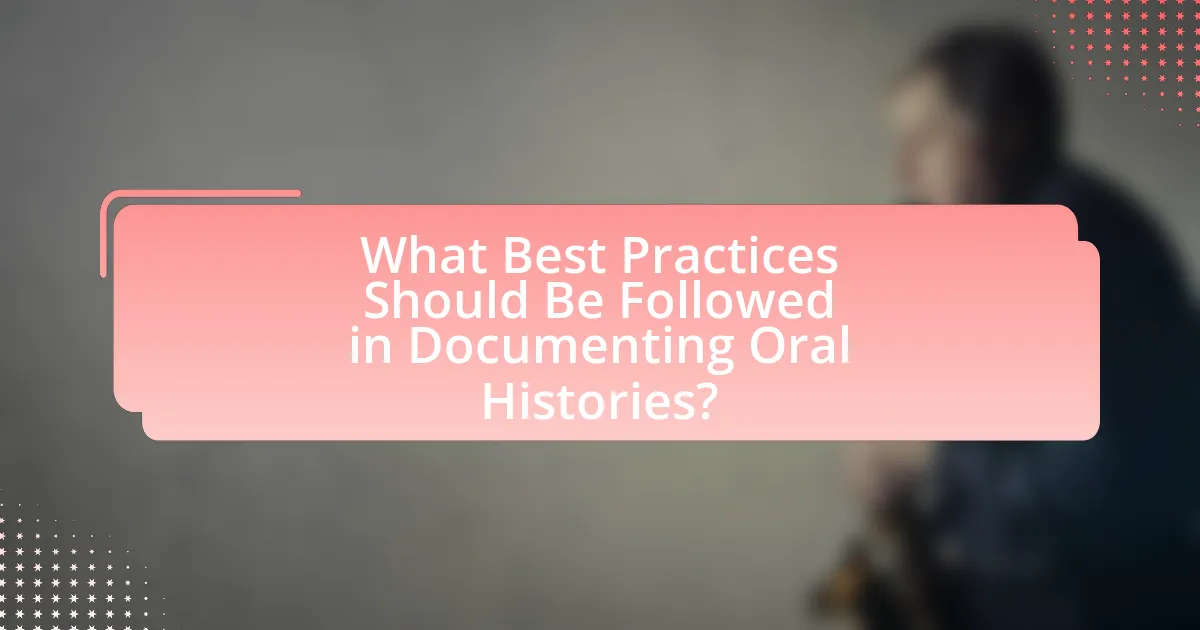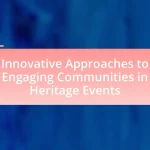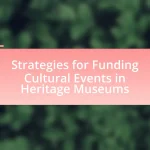Documenting oral histories is a vital practice in heritage museums, involving the systematic collection and preservation of personal narratives that enrich cultural heritage and community identity. This article explores the significance of oral histories in enhancing museum collections, fostering community engagement, and preserving diverse perspectives, particularly from marginalized groups. It discusses the methodologies and technologies used in documenting these histories, the ethical considerations involved, and the challenges faced in collecting narratives from diverse communities. Additionally, the article highlights best practices for conducting oral history interviews and the integration of these narratives into museum exhibits to create a more immersive visitor experience.

What is Documenting Oral Histories in Heritage Museums?
Documenting oral histories in heritage museums involves the systematic collection and preservation of personal narratives and testimonies from individuals about their experiences, cultural practices, and historical events. This practice enriches the museum’s collections by providing firsthand accounts that offer deeper insights into the community’s heritage and cultural identity. For instance, the Smithsonian Institution has implemented oral history projects to capture diverse perspectives, ensuring that marginalized voices are included in the historical narrative. This method not only enhances the educational value of exhibits but also fosters community engagement and intergenerational dialogue, making it a vital component of heritage preservation.
Why is documenting oral histories important for heritage museums?
Documenting oral histories is important for heritage museums because it preserves personal narratives that enrich the understanding of cultural heritage. These narratives provide unique insights into the lived experiences of individuals, reflecting diverse perspectives that are often absent from traditional historical records. For instance, oral histories can capture the voices of marginalized communities, ensuring their stories are included in the broader historical narrative. This practice not only enhances the museum’s collections but also fosters community engagement and connection, as individuals relate to and learn from the stories of others.
What role do oral histories play in preserving cultural heritage?
Oral histories play a crucial role in preserving cultural heritage by capturing personal narratives and experiences that reflect the values, traditions, and histories of communities. These narratives provide a rich, nuanced understanding of cultural practices and social dynamics that are often overlooked in written records. For instance, oral histories can document unique dialects, storytelling traditions, and local customs, which contribute to the identity of a community. Research indicates that oral histories are vital for intergenerational transmission of knowledge, as they allow younger generations to connect with their heritage through firsthand accounts. This method of preservation is particularly important for marginalized groups whose histories may not be adequately represented in mainstream historical narratives.
How do oral histories enhance visitor engagement in museums?
Oral histories enhance visitor engagement in museums by providing personal narratives that create emotional connections to the exhibits. These firsthand accounts allow visitors to relate to historical events on a human level, making the experience more immersive and relatable. For instance, a study by the American Alliance of Museums found that visitors who interacted with oral histories reported a 30% increase in their emotional engagement compared to traditional exhibits. This engagement is further amplified when visitors can listen to stories from individuals who experienced the events firsthand, fostering a deeper understanding of the cultural and historical context.
What methods are used for documenting oral histories?
Methods used for documenting oral histories include audio recording, video recording, and transcription. Audio recording captures the spoken narratives of individuals, preserving their tone and emotion, while video recording adds a visual element that conveys body language and context. Transcription involves converting spoken words into written text, which aids in analysis and accessibility. These methods are essential for creating accurate and lasting records of personal experiences, as evidenced by projects like the Library of Congress’s American Folklife Center, which utilizes these techniques to archive diverse cultural narratives.
What technologies are commonly employed in oral history documentation?
Common technologies employed in oral history documentation include digital audio recorders, video cameras, and transcription software. Digital audio recorders capture high-quality sound, allowing for clear interviews that preserve the nuances of spoken language. Video cameras enhance the documentation by providing visual context, capturing body language and expressions that enrich the oral narratives. Transcription software facilitates the conversion of recorded interviews into text, making it easier to analyze and archive the content. These technologies collectively ensure that oral histories are accurately recorded, preserved, and accessible for future generations.
How do interview techniques impact the quality of oral histories?
Interview techniques significantly impact the quality of oral histories by influencing the depth and accuracy of the information gathered. Effective techniques, such as open-ended questions and active listening, encourage interviewees to share detailed narratives, leading to richer and more nuanced accounts. Research indicates that interviews conducted with a focus on building rapport and trust yield more authentic responses, as participants feel comfortable sharing personal experiences. For instance, a study by the Oral History Association highlights that interviews that prioritize participant engagement result in oral histories that are not only more comprehensive but also more reflective of the interviewee’s lived experiences.
What challenges are faced in documenting oral histories?
Documenting oral histories faces several challenges, including issues of accuracy, memory reliability, and ethical considerations. Accuracy can be compromised due to the subjective nature of personal recollections, which may be influenced by emotions or biases. Memory reliability is a significant concern, as individuals may forget details or alter their narratives over time, leading to discrepancies in the historical record. Ethical considerations arise when obtaining consent and ensuring that the voices of marginalized groups are represented fairly and respectfully. These challenges necessitate careful methodologies and critical engagement to preserve the integrity of oral histories.
How do ethical considerations affect oral history projects?
Ethical considerations significantly affect oral history projects by guiding the treatment of participants and the integrity of the collected narratives. These considerations ensure that the rights, dignity, and privacy of interviewees are respected, which is crucial for building trust and encouraging participation. For instance, obtaining informed consent is a fundamental ethical requirement, as it allows participants to understand how their stories will be used and shared. Additionally, ethical guidelines often emphasize the importance of accuracy and representation, ensuring that the narratives reflect the interviewees’ perspectives without distortion. This adherence to ethical standards not only protects individuals but also enhances the credibility and scholarly value of the oral history project, as seen in established practices by organizations like the Oral History Association, which provides a code of ethics for practitioners.
What are the common obstacles in collecting oral histories from diverse communities?
Common obstacles in collecting oral histories from diverse communities include language barriers, mistrust of outsiders, and differing cultural norms regarding storytelling. Language barriers can hinder effective communication, making it difficult for interviewers to engage participants fully. Mistrust often arises from historical injustices or exploitation, leading individuals to be reluctant to share their stories. Additionally, cultural norms may dictate how stories are told or who is considered an appropriate storyteller, complicating the collection process. These factors collectively impede the gathering of comprehensive and authentic oral histories from diverse communities.

How do Heritage Museums Utilize Documented Oral Histories?
Heritage museums utilize documented oral histories to preserve and present the personal narratives and cultural experiences of individuals, thereby enriching their exhibitions and educational programs. By integrating these oral histories, museums create a more immersive and relatable understanding of historical events, allowing visitors to connect emotionally with the past. For instance, the Smithsonian Institution has effectively used oral histories to highlight the experiences of marginalized communities, ensuring diverse perspectives are represented in their collections. This approach not only enhances the authenticity of the museum’s narrative but also fosters community engagement and participation in the preservation of cultural heritage.
In what ways are oral histories integrated into museum exhibits?
Oral histories are integrated into museum exhibits through audio recordings, video interviews, and interactive displays that feature personal narratives. These methods allow museums to present diverse perspectives and lived experiences, enhancing the storytelling aspect of exhibits. For instance, the Smithsonian Institution incorporates oral histories in its exhibitions by using recorded interviews to provide context and depth to artifacts, thereby creating a more immersive experience for visitors. This integration not only preserves cultural heritage but also fosters a connection between the audience and the subjects of the histories, making the exhibits more relatable and impactful.
How do oral histories complement traditional artifacts in exhibitions?
Oral histories complement traditional artifacts in exhibitions by providing personal narratives that enhance the understanding of cultural contexts. While artifacts represent tangible evidence of history, oral histories offer insights into the lived experiences and meanings associated with those artifacts. For instance, a traditional garment displayed in an exhibition may be accompanied by an oral history that recounts its significance in specific rituals or family traditions, thereby enriching the audience’s appreciation of the artifact. This combination fosters a more holistic representation of heritage, as evidenced by studies showing that visitors engage more deeply with exhibitions that include both artifacts and personal stories, leading to a greater emotional connection and understanding of the culture being represented.
What are the benefits of using multimedia formats for presenting oral histories?
Using multimedia formats for presenting oral histories enhances engagement and accessibility. These formats, which include video, audio, and interactive elements, allow for a richer storytelling experience that captures the emotional nuances of personal narratives. Research indicates that multimedia presentations can increase retention of information by up to 60% compared to traditional text-based formats, as they cater to various learning styles and preferences. Additionally, multimedia can reach a broader audience, including those with disabilities, by providing captions, transcripts, and visual aids, thereby promoting inclusivity in heritage museums.
How do museums ensure the preservation of oral histories?
Museums ensure the preservation of oral histories by employing systematic recording methods, archiving practices, and community engagement initiatives. They utilize audio and video recording technologies to capture firsthand accounts, ensuring high-quality documentation of personal narratives. Additionally, museums often digitize these recordings and store them in secure databases, which facilitates long-term access and preservation. For instance, the Smithsonian Institution has developed guidelines for oral history projects that emphasize ethical considerations and technical standards, ensuring that the collected histories are preserved accurately and respectfully. Furthermore, museums engage with local communities to encourage participation in oral history projects, fostering a sense of ownership and relevance, which enhances the sustainability of these initiatives.
What archival practices are essential for maintaining oral history collections?
Essential archival practices for maintaining oral history collections include proper documentation, preservation, and access management. Documentation involves creating detailed metadata for each oral history interview, including information about the interviewee, the context of the interview, and the date of recording. Preservation requires using high-quality storage formats and environments to protect audio and video recordings from degradation, ensuring that digital files are backed up in multiple locations. Access management entails establishing clear policies for how and when these collections can be accessed by researchers and the public, which is crucial for ethical considerations and the protection of sensitive information. These practices are supported by guidelines from organizations such as the Oral History Association, which emphasizes the importance of these steps in safeguarding the integrity and longevity of oral history collections.
How do museums balance accessibility and preservation of oral histories?
Museums balance accessibility and preservation of oral histories by implementing digital archiving and community engagement strategies. Digital archiving allows museums to store oral histories in formats that are easily accessible to the public while ensuring the original recordings are preserved in controlled environments. For instance, the Smithsonian Institution has developed online platforms that provide access to oral history collections, enabling wider public engagement without compromising the integrity of the original materials. Additionally, museums often involve community members in the documentation process, which fosters a sense of ownership and encourages the sharing of diverse narratives, thus enhancing both accessibility and preservation efforts.

What Best Practices Should Be Followed in Documenting Oral Histories?
Best practices in documenting oral histories include obtaining informed consent, ensuring accurate transcription, and preserving audio-visual quality. Informed consent allows participants to understand how their stories will be used, fostering trust and ethical engagement. Accurate transcription is crucial for maintaining the integrity of the narratives, as it captures the speaker’s voice and intent. Preserving audio-visual quality involves using reliable recording equipment and appropriate settings to minimize background noise, which enhances the clarity of the oral histories. These practices are supported by guidelines from organizations such as the Oral History Association, which emphasizes ethical standards and technical quality in oral history projects.
What guidelines should be followed for conducting oral history interviews?
To conduct oral history interviews effectively, interviewers should follow guidelines that ensure respectful, accurate, and comprehensive documentation of personal narratives. First, interviewers must prepare by researching the interviewee’s background and formulating open-ended questions that encourage detailed responses. This approach fosters a comfortable environment, allowing the interviewee to share their experiences freely.
Additionally, interviewers should obtain informed consent, explaining the purpose of the interview and how the information will be used, which aligns with ethical standards in oral history practices. During the interview, active listening is crucial; interviewers should engage with the interviewee’s responses, asking follow-up questions to clarify and deepen the conversation.
Recording the interview with high-quality audio or video equipment is essential for preserving the integrity of the narrative. After the interview, transcribing the conversation accurately is necessary for future reference and analysis. These guidelines are supported by organizations such as the Oral History Association, which emphasizes the importance of ethical practices and thorough documentation in oral history projects.
How can interviewers build rapport with participants to enhance storytelling?
Interviewers can build rapport with participants by actively listening and demonstrating empathy, which enhances storytelling. Active listening involves giving full attention to the participant, acknowledging their feelings, and responding appropriately, creating a safe space for sharing. Demonstrating empathy allows interviewers to connect on a personal level, making participants feel valued and understood. Research indicates that when participants feel comfortable and respected, they are more likely to share detailed and meaningful stories, as evidenced by studies in qualitative research methodologies that highlight the importance of trust in eliciting rich narratives.
What ethical guidelines should be considered during the documentation process?
During the documentation process, ethical guidelines such as informed consent, confidentiality, and respect for the subject’s dignity must be considered. Informed consent ensures that participants understand the purpose of the documentation and agree to their stories being recorded and shared. Confidentiality protects sensitive information, allowing subjects to share their experiences without fear of repercussions. Respect for dignity involves acknowledging the cultural and personal significance of the narratives being documented, ensuring that the subjects are portrayed accurately and respectfully. These guidelines are essential to maintain trust and integrity in the documentation process, as highlighted by the American Alliance of Museums, which emphasizes ethical practices in museum documentation.
What resources are available for museums to improve their oral history projects?
Museums can access various resources to enhance their oral history projects, including training programs, digital tools, and funding opportunities. Organizations such as the Oral History Association provide guidelines and best practices for conducting interviews, while platforms like StoryCorps offer technology and support for recording and sharing oral histories. Additionally, grants from institutions like the National Endowment for the Humanities can financially support oral history initiatives. These resources collectively empower museums to effectively document and preserve personal narratives, ensuring a richer representation of cultural heritage.
How can museums collaborate with universities and organizations for oral history initiatives?
Museums can collaborate with universities and organizations for oral history initiatives by establishing partnerships that leverage academic resources, expertise, and community networks. These collaborations can involve joint research projects, where universities provide methodological support and training in oral history techniques, while museums offer access to their collections and community connections. For instance, the University of Southern California’s Oral History Research Center has partnered with local museums to document the experiences of diverse communities, resulting in valuable archival materials that enhance both educational and cultural narratives. Such partnerships not only enrich the oral history projects but also foster interdisciplinary learning and community engagement.
What training opportunities exist for museum staff in oral history documentation?
Training opportunities for museum staff in oral history documentation include workshops, online courses, and certification programs offered by organizations such as the Oral History Association and various universities. These programs typically cover methodologies for conducting interviews, ethical considerations, and techniques for archiving and preserving oral histories. For instance, the Oral History Association provides resources and training sessions that focus on best practices in oral history documentation, ensuring that museum staff are equipped with the necessary skills to effectively capture and preserve personal narratives.
What are some practical tips for successful oral history documentation?
Successful oral history documentation requires careful planning and execution. First, prepare a structured interview guide that includes open-ended questions to encourage detailed responses. This approach allows interviewees to share their experiences fully, enhancing the richness of the documentation. Second, ensure high-quality recording equipment is used to capture clear audio, as poor sound quality can hinder the usability of the recordings. Third, obtain informed consent from participants, which is essential for ethical documentation practices and protects their rights. Additionally, transcribe interviews promptly to preserve the content accurately and facilitate analysis. Finally, organize and archive the recordings and transcripts systematically, making them accessible for future research and reference. These practices are supported by the American Folklife Center, which emphasizes the importance of thorough preparation and ethical considerations in oral history projects.


